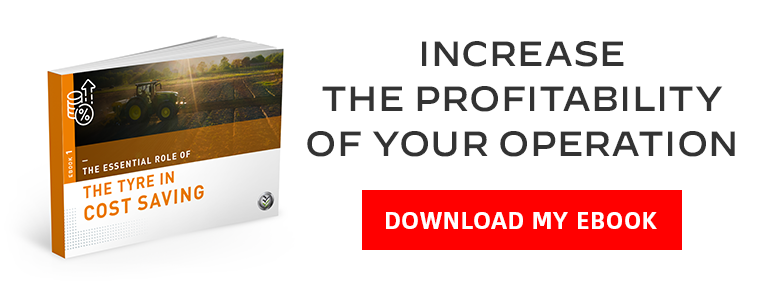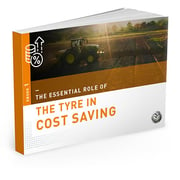Braking is a central element for the safety of your agricultural machines which travel by road, especially when you are at the wheel of a loaded tractor, pulling a full trailer or during harvesting.
Whether you are in the middle of the countryside or coming up to an intersection, the braking capacity of your combination vehicle can make the difference between a completely safe stop and an inadequate stop with unpleasant consequences.
Your agricultural tyres play a decisive role in this equation. Their adherence to the ground is vital, not just in bearing the weight of your vehicle, but also for transmitting the braking power necessary to come to a stop quickly. Unfortunately not all tyres are equal in terms of braking. Poor adherence can dangerously extend your braking distance, putting your equipment in danger as well as your own safety.
In this article we look at the importance of the choice of tyre in the context of emergency braking and the consequences of unsuitable equipment, in order to help you make better choices for your own safety as well as for the safety of your agricultural equipment.
1. What are the high-strain zones in agricultural tyres during braking?
Braking mid-field is not a problem as your tyres are designed to work the earth. The soil is pushed downwards under the tyre until it meets sufficient resistance. The full length of the lugs grip into the earth which makes braking very efficient, allowing you to come to a stop in complete safety.
The situation is totally different on the road, because the ground is hard and resistant. In this case it’s not the ground that changes its structure to stop your trailer, just your tyres.

on the road during cornering and braking
The main high-strain zones during braking are as follows:
The base of the lugs
During emergency braking on the road or on hard ground, it’s the lugs which bear the strain between the contact area with the ground and the structure of the casing. They undergo sheer stress which can cause them to tear off them from their base.
This phenomenon is accentuated in the presence of a poor quality rubber compound which is too soft, or if the tyre is worn or ageing and the rubber has lost its original suppleness. This can lead to loss of adherence and reduce braking efficiency considerably.
The quality of the tread and its cohesion with the casing
The tread has a huge influence in terms of braking. It is made up of stabilising plies which ensure good control of steering and road handling capacities.
These plies help to make the tyre stable on the ground by spreading the pressure exerted by the load evenly. A quality tyre generally has more stabilising plies than a low-cost tyre, which will make all the difference during emergency braking.
The tread and the casing must form a solid, compact and cohesive unit to obtain an even spread of the strain caused by braking.
The bead-rim connection
The bead of the tyre acts as the link with the rim simply through the force of the internal pressure of the tyre.
During braking, this zone faces a very high level of strain which can cause rotation on the rim, leading to overheating of the connecting rubber at the level of the friction area, making the tyre unfit for use.
If the tyre is not the right size for the rim, if the pressure is insufficient or if the rim is slightly misshapen, emergency braking can result in the tyre coming off the rim or even bursting in the worst case scenario.
2. What is the link between speed/load and braking?
Braking force: a delicate balance to be found
When a tractor brakes, the braking force acts directly between tyre and ground, it’s the tyre’s resistance to the ground that makes it possible to slow the machine down.
This forces is linked to the tyre’s adherence, depending on numerous factors such as the type of ground, the state of the ground, the tyre pressure, the quality of the tyre and the extent to which it is worn.
The slowing down speed is directly linked to the balance between opposing forces: the power of the braking system, the trailer mass, the combination vehicle mass and the tyres’ adherence to the ground.

tractor mass and tyre adherence to the ground
Transfer of mass and distribution of forces during braking
When the tractor decelerates sharply, the mass shifts to the front due to inertia.
The front axle which was bearing the normal mass has to cope with the dynamic load as well, which is in proportion to the combination vehicle mass.
The rear axle is relieved of a considerable weight and may tend to lift up, further overloading the front axle. This transfer of mass has a direct impact on braking efficiency.
If the front axle is overloaded at the time of braking, it may rapidly overheat and, depending on the quality of the tyres, lose its grip.

with loss of adherence at the level of the front axle
If you are towing a trailer, the mass transfer takes place from the trailer to the rear axle of the tractor, which allows the rear axle to be flattened to the ground, reduces the transfer of mass to the front axle and improves braking efficiency in the 4 tractor wheels, which act together.
Speed has a direct impact on braking distance
Your tractor’s main purpose is not to go fast, but to work the land at low speed. Speed is really a decisive factor in terms of braking distance.

The braking distance is calculated using the square of the speed. This means that you have to multiply the speed by itself to calculate the distance necessary to bring the vehicle to a stop.
So when you double your speed by going from 20 to 40 km/h you will need 4 times more distance to bring the combination vehicle to a complete stop.
Example:
- 20 km/h: 10 × 20 km/h: 10 = 4 metres to stop
- 40 km/h: 10 × 40 km/h: 10 = 16 metres to stop
This distance will become even longer:
- If you are loaded, in proportion to the load.
- Based on your tyres’ adherence to the ground.
- If you are on a wet road, it will be multiplied by 2 with low-cost tyres.
- Based on the driver’s reaction time, 1 second represents between 10 and 20 metres more.
The faster the vehicle is driving and the heavier it is, the more the kinetic energy to be dissipated increases. The kinetic energy corresponds to the mass of the moving vehicle.
On braking, this energy is evacuated in the form of heat in the braking system and by the tyres’ capacity to stick to the ground.

the braking mechanism is evacuated in the form of heat
3. What level of pressure should you use to get the best braking capacity?
The importance of pressure for braking
The role of tyre pressure in braking is often underestimated. Yet it has a direct influence on the tyre’s ability to cope with the load transfer.
The higher the tyre pressure, the greater the rigidity of the tyre which improves its ability to stay in line at the time of braking. Inversely, a low inflation pressure will not be enough to resist the normal mass plus the dynamic load at the time of braking.
Too low an inflation pressure may deform the tyre during braking, making it less efficient and squashing the sidewalls at the level of the beads which will reduce adherence, especially on wet or slippery surfaces.

to reduce the braking distance
Adapting pressure based on use
Work in the fields: lower pressure is generally recommended to increase the contact patch with the ground, thus improving traction and reducing soil compaction. Braking in the fields is not a problem because in general speeds are lower and the full length of the lugs grip into the ground making it easy to stop the combination vehicle.
Driving on the road: higher pressure, above 1.8 bar (to be adapted depending on the load) is preferable to improve the rigidity of the tyre, stability and road handling, especially when cornering. Too much pressure can lead to overheating and damage to the tyre.
It is essential to adapt pressure depending on the situation, because what’s right in the field is not necessarily right for the road.

to improve road handling capacities in the event of sharp braking
4. The advantages of premium tyres for good braking capacity
Premium agricultural tyres, such as Bridgestone’s VX-R TRACTOR and VX-TRACTOR tyres, offer much better braking efficiency than standard market tyres.
This greater capacity is the fruit of several years of research and development, a meticulous design and the use of high quality materials.
VX-R TRACTOR tyre: optimised adherence
VX-R TRACTOR tyres have a wider tread, which corresponds to the width indicated on the sidewall. This feature improves the tyres’ adherence to the ground thanks to the bigger contact patch.
In addition, the S-Line bead reinforces the connection between the tyre and the rim, increasing the tyre’s capacity to absorb torque, without the bead slipping on the rim.
Exceptional resistance and longevity
VX-R TRACTOR tyres are made with high quality rubber compounds which make them more resistant to wear.
Their reinforced casing allows them to bear heavy loads, which will be necessary during emergency braking.

which is very efficient during braking
VX-TRACTOR tyres are more resistant for intensive use on the road
The tread and lug design influence the size of the tyre’s contact patch with the road.
With 20% more rubber volume, VX-TRACTOR tyre lugs have a large, even contact area with the ground. This advantage can be useful in increasing vehicle adherence during braking.
The sturdy casing of Bridgestone tyres has been engineered to provide better resistance to damages, even at a higher inflation pressure. They were developed to cope with a pressure of 2.4 bar, which is a considerable advantage when braking, particularly when your tractor is loaded. The casing’s resistance has been optimised to minimise internal strain, leading to improved durability.
These characteristics contribute towards improving stability on the road, limiting any swaying effect and increasing tyre resistance. They can procure a real advantage during difficult braking.

CONCLUSION
Tractor braking is a complex process influenced by numerous factors, such as the choice of tyres, their inflation pressure and the state of the road.
For your safety, opt for premium tyres which improve tractor performance thanks to innovative technologies and high-quality materials.
At Bridgestone, a large range of agricultural tyres is available to meet your specific needs. You are spoilt for choice with the VX-R TRACTOR and VX-TRACTOR tyres.
By choosing from among these tyre models, you are investing in the safety and durability of your equipment. These tyres offer exceptional adherence, increased stability and reduce the risks of losing adherence during braking.
The Bridgestone-agriculture.eu blog is written and administered by tractor tyre experts who are available to provide you with the advice you need on the subject of your agricultural tyres. They allow you to maximise your productivity with information on all subjects linked to tyres: Cheap tractor tyres — Technical data for agricultural tyres — Air pressure advice — Solutions to avoid soil compaction — Sprayer tyre pressure — Why and how to ballast your tractor tyres — When to use dual wheels — The mechanical causes of abnormal wear — Cheap agricultural tyres – etc.
To learn more and boost your farm's profits, Bridgestone-Agriculture is offering you a free, detailed white paper that explains the essential role your agricultural tyres play in your productivity.
Most people who read this article have also read some of the following articles:
- 5 essential techniques to optimise your agricultural tyres
- What is the impact of the section width of your agricultural tyres
- Do my tractor tyres have a wide enough footprint?
- Can my agricultural tyres help reduce my fuel consumption?
- Does improper lead invalidate your agricultural tyre warranty?
- How can you manage the rolling resistance in agricultural tyres better?
- What are agricultural tyres’ high-strain zones?
- Should you change the rim for wide agricultural tyres?
- Is a premium rim better suited to my tractor tyres?
- What is the link between the environmental impact of tyres and your profitability
This information is intended only to make you aware of the technical and functional aspects of agricultural tires and their use. It does not allow you to make a judgment or a definitive conclusion on a given problem. Only your agricultural tire expert is able to make a technical assessment and take a final decision, case by case.
Leave a
commentary
Your email address will not be published.
Required fields are indicated with *








